Lesson 1: The Basics
Welcome to Lesson 1: The Basics! If this is your first time learning music theory, this is the place for you! In this lesson we will focus basic ideas such as:

- What is music theory?
- What are chords/notes/keys?
- How are modern songs made?

What is Music Theory?
Music Theory is defined as "the study of the theoretical elements of music including sound and pitch, rhythm, melody, harmony, and notation." [1] Okay... so what does that actually mean? Basically, Music Theory (MT for short) is what all musicians must understand in order to make excellent music.
Ever see a piece of sheet music that looks like this and have no idea what it means
Yeah, us too. What does "E Minor" mean anyway? Luckily, this lesson will teach you all you need to know to be able to decode this concoction of lines and dots in no time!
Ever see a piece of sheet music that looks like this and have no idea what it means

Yeah, us too. What does "E Minor" mean anyway? Luckily, this lesson will teach you all you need to know to be able to decode this concoction of lines and dots in no time!
Staff and Notation
All music is composed of notes on a staff. The staff consists of 5 horizontal lines as shown below, with "ledger lines" that go above or below the staff. It is the "house" of all the notes in the song.
Notes are what go on the staff. The position of note on the staff tells you how high or low the pitch is. The higher on the staff, the higher the pitch, and vice versa.
This note will have a high pitch:
Whereas this note will have a lower pitch:
Notes are played for different lengths depending on the type of note. In 4/4 or common time, a whole note get 4 beats. A half note gets half of that, and a quarter note gets half of a half note. This pattern continues on until the 256th note.
This symbol at the beginning of the sheet music is called a "clef." There are two main clefs in music: the high one (Treble) and the low one (Bass).
They are connected by a note called "middle C." C is the central note for all music, so pay attention to that one.
The notes on the lines of the treble clef are E, G, B, D, F. A mnemonic device to remember this is "Every Good Boy Does Fine."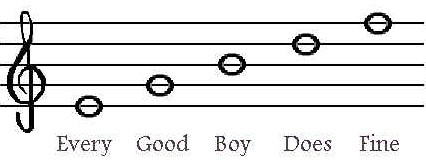
The spaces are F, A, C, E. This is easy to remember, as it spells out the word "Face."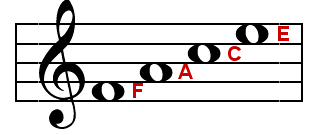
The notes on the lines of the bass clef are G, B, D, F, A. A mnemonic device to remember this is "Good Bikes Don't Fall Apart."
The spaces are A, C, E, G. A mnemonic device to remember this is "All Cows Eat Grass."
The notes in music are A, A#/Bb (A sharp/B flat), B, C, C#/Db, E, F, F#/Gb, G, G#/Ab, and then it repeats.
As you can see, there are only 8 whole notes with 5 half steps. This makes a total of 13 notes total in all of music, the only difference is the octave played they're played in.
Notes that are "sharp" are played a half step higher than regular.
Notes that are "flat" are played a half step lower than regular.
All notes are played "natural," (no sharps or flats) unless otherwise noted by the "key" of the song. The key tells you which notes to play.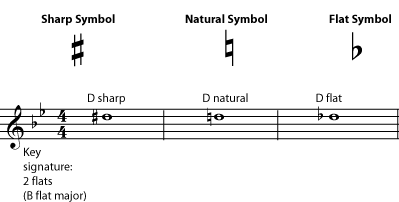
This key has one sharp in it. It is the key of G major. The sharp in this key is F. That means every time the note F appears in the song, it will be sharp.
In the key of C, there are no sharps or flats. In G major this is one sharp, and in D major there are 2 sharps. There is a very simple infographic to remember this information and memorize different keys if you so choose. This is called the "Circle of Fifths" as shown below.
Now that you know the Staff and Notation, the rest of the lesson will divided into 4 sections: Genres, Instruments, Band, and Orchestra.
Feel free to move about the lesson as you choose, but be sure to read all of it to prepare you for the game to be played after.
Notes are what go on the staff. The position of note on the staff tells you how high or low the pitch is. The higher on the staff, the higher the pitch, and vice versa.
This note will have a high pitch:

Whereas this note will have a lower pitch:

Notes are played for different lengths depending on the type of note. In 4/4 or common time, a whole note get 4 beats. A half note gets half of that, and a quarter note gets half of a half note. This pattern continues on until the 256th note.
This symbol at the beginning of the sheet music is called a "clef." There are two main clefs in music: the high one (Treble) and the low one (Bass).
They are connected by a note called "middle C." C is the central note for all music, so pay attention to that one.

The notes on the lines of the treble clef are E, G, B, D, F. A mnemonic device to remember this is "Every Good Boy Does Fine."
The spaces are F, A, C, E. This is easy to remember, as it spells out the word "Face."

The notes on the lines of the bass clef are G, B, D, F, A. A mnemonic device to remember this is "Good Bikes Don't Fall Apart."

The spaces are A, C, E, G. A mnemonic device to remember this is "All Cows Eat Grass."

The notes in music are A, A#/Bb (A sharp/B flat), B, C, C#/Db, E, F, F#/Gb, G, G#/Ab, and then it repeats.
As you can see, there are only 8 whole notes with 5 half steps. This makes a total of 13 notes total in all of music, the only difference is the octave played they're played in.
Notes that are "sharp" are played a half step higher than regular.
Notes that are "flat" are played a half step lower than regular.
All notes are played "natural," (no sharps or flats) unless otherwise noted by the "key" of the song. The key tells you which notes to play.
This key has one sharp in it. It is the key of G major. The sharp in this key is F. That means every time the note F appears in the song, it will be sharp.

In the key of C, there are no sharps or flats. In G major this is one sharp, and in D major there are 2 sharps. There is a very simple infographic to remember this information and memorize different keys if you so choose. This is called the "Circle of Fifths" as shown below.

Now that you know the Staff and Notation, the rest of the lesson will divided into 4 sections: Genres, Instruments, Band, and Orchestra.
Feel free to move about the lesson as you choose, but be sure to read all of it to prepare you for the game to be played after.
Genres
A "genre" of music is a classification given to music that follows certain conventions. [2] Different types of Genres include classical, pop, opera, R&B, and rap to name a few. People tend to have favorites depending on what their particular taste is, but no one genre can be considered better than another.
When writing a song, it is imperative to consider what the genre of the song is. This will guide the musician, as some genres have very particular structure and sound. You will read about some of the most popular genres and understand how composers make their music.
When writing a song, it is imperative to consider what the genre of the song is. This will guide the musician, as some genres have very particular structure and sound. You will read about some of the most popular genres and understand how composers make their music.
Pop
Whether it's in the car radio, grocery store music, or just playing on a playlist, almost everyone is familiar with pop, or popular, music.
 This is because pop music appeals to the current trends and a general audience, instead of a particular group.
Pop songs have a simple structure:
This is because pop music appeals to the current trends and a general audience, instead of a particular group.
Pop songs have a simple structure:

By following this pattern, anyone can make a pop song. Pop songs usually stick to simple chords with a repeating beat. The most common chords in pop music is the I-V-vi-IV [3] progression. Basically, two major chords, followed by a minor chord, finished by a major chord. Songs that use this progression include "Africa" by Toto, "Bad Blood" by Taylor Swift, and "Cheap Thrills" by Sia, among countless others.
Pop songs are usually sung by one person, recorded in a studio with no live instruments, and based around a topic like love or partying-- something that will appeal to a large audience.
 This is because pop music appeals to the current trends and a general audience, instead of a particular group.
Pop songs have a simple structure:
This is because pop music appeals to the current trends and a general audience, instead of a particular group.
Pop songs have a simple structure:
- Verse
- Chorus
- Verse
- Chorus
- Bridge
- Chorus

By following this pattern, anyone can make a pop song. Pop songs usually stick to simple chords with a repeating beat. The most common chords in pop music is the I-V-vi-IV [3] progression. Basically, two major chords, followed by a minor chord, finished by a major chord. Songs that use this progression include "Africa" by Toto, "Bad Blood" by Taylor Swift, and "Cheap Thrills" by Sia, among countless others.
Pop songs are usually sung by one person, recorded in a studio with no live instruments, and based around a topic like love or partying-- something that will appeal to a large audience.

Rock
Rock music [4] is a little bit more complicated than pop, but still follows a basic structure. It may or may not use the same Verse-Chorus pattern as pop, but it can diverge into different bridges at different times, but usually uses those 3 elements.
Rock music rarely strays from major and minor chords/keys, and uses a common progression: IV-V-I. A major fourth, major fifth, and major first.
Rock music uses live instruments, usually is performed by a band, and does not use as many studio/recording effects as pop. The lead singer usually sings with a powerful voice and is a bit heavier than pop. Rock songs include "Bohemian Rhapsody" by Queen, "Stairway to Heaven" by Led Zeppelin, and "Smells Like Teen Spirit" by Nirvana.
Rock music rarely strays from major and minor chords/keys, and uses a common progression: IV-V-I. A major fourth, major fifth, and major first.
Rock music uses live instruments, usually is performed by a band, and does not use as many studio/recording effects as pop. The lead singer usually sings with a powerful voice and is a bit heavier than pop. Rock songs include "Bohemian Rhapsody" by Queen, "Stairway to Heaven" by Led Zeppelin, and "Smells Like Teen Spirit" by Nirvana.
Musical Theatre
Musical Theatre [5] is a genre of music that is found in musicals, such as "Little Shop of Horrors," "Urinetown," and "Rent." These songs are used intermittently throughout musicals, or all through to tell the story of the play.

Musical songs don't have to follow any particular structure, and can just be one long verse.

Musical songs tend to show off the performers vocals, so they will often feature very high notes, very low notes, vibrating notes, or any other type of showy singing. The lead or main singer will often have an ensemble, or company, backing him/her up to make the music sound more lively and full.
Musical songs that are common in today's culture are "Suddenly Seymour" from Little Shop of Horrors, "Seasons of Love" from Rent, and "Alexander Hamilton" from Hamilton.

Musical songs don't have to follow any particular structure, and can just be one long verse.

Musical songs tend to show off the performers vocals, so they will often feature very high notes, very low notes, vibrating notes, or any other type of showy singing. The lead or main singer will often have an ensemble, or company, backing him/her up to make the music sound more lively and full.
Musical songs that are common in today's culture are "Suddenly Seymour" from Little Shop of Horrors, "Seasons of Love" from Rent, and "Alexander Hamilton" from Hamilton.

Instruments
Many different types of instruments are played in music. [6] From the common guitar and violin to the eccentric glockenspiel and imperial bösendorfer (a piano with an extra lower octave), music is defined by what instruments are in it. There are 4 "families" of instruments-- String, Woodwind, Percussion, and Brass.
String Instruments String instruments are instruments that-- you guessed it -- use strings to create sound. By plucking, strumming, or using a bow, the strings vibrate, creating music. The finger position on the strings is what changes the pitch of the note. Playing an "open string"(no fingers placed on it) will give you the lowest note that string can play. By moving your finger up the instrument, you will get a higher and higher pitch.
String instruments are instruments that-- you guessed it -- use strings to create sound. By plucking, strumming, or using a bow, the strings vibrate, creating music. The finger position on the strings is what changes the pitch of the note. Playing an "open string"(no fingers placed on it) will give you the lowest note that string can play. By moving your finger up the instrument, you will get a higher and higher pitch.

Woodwind Instruments Woodwind instruments are instruments that are typically made from wood that require air to be blown into them to make sound. These instruments often times require reeds, little pieces of wood that allow the vibrations to occur. However, not all woodwind instruments do. Woodwinds change pitch by pressing different keys on the instrument, which closes or opens holes on it, causing a different pitch to transmit.
Woodwind instruments are instruments that are typically made from wood that require air to be blown into them to make sound. These instruments often times require reeds, little pieces of wood that allow the vibrations to occur. However, not all woodwind instruments do. Woodwinds change pitch by pressing different keys on the instrument, which closes or opens holes on it, causing a different pitch to transmit.

Percussion Instruments Percussion instruments are instruments that you hit (with mallet or hand), shake, or clap together to make noise. Percussion instruments are the beat makers of a song and keep time, such as the drum set or djembe. However, percussion instruments can also play music such as the timpani and piano, which is often times misclassified.
Percussion instruments are instruments that you hit (with mallet or hand), shake, or clap together to make noise. Percussion instruments are the beat makers of a song and keep time, such as the drum set or djembe. However, percussion instruments can also play music such as the timpani and piano, which is often times misclassified.
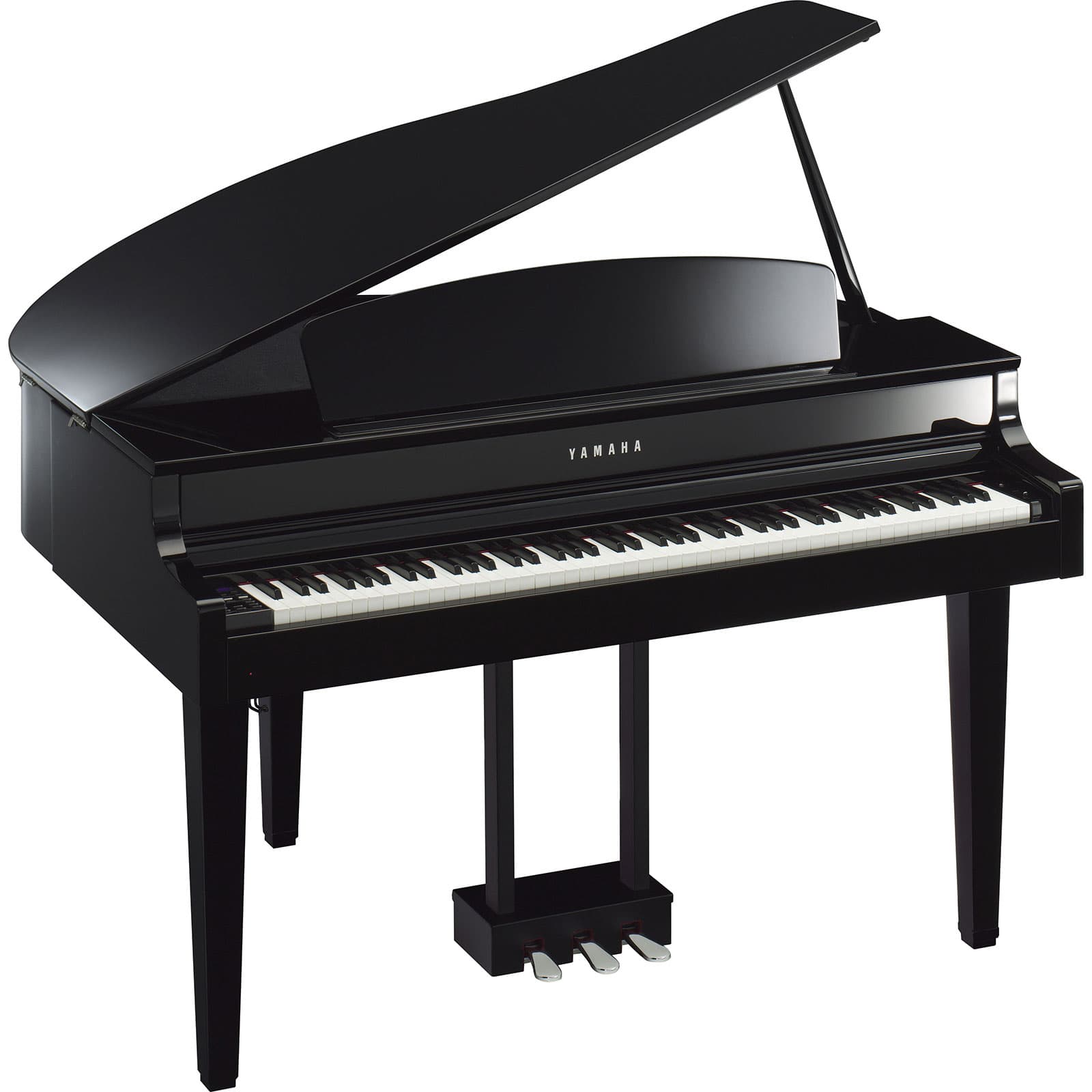
Brass Instruments Brass instruments are instruments that are played similar to woodwinds, but without reeds. They use a metal mouthpiece and require specific positioning of the players lips to produce sound. So, while it may look like the trumpet has very little keys and therefore can play a small amount of notes, it actually has a large range and just requires different buzzing and air from the mouth to make them. Unlike woodwinds, which play one note per finger positioning, brass can play many notes with the same positioning.
Brass instruments are instruments that are played similar to woodwinds, but without reeds. They use a metal mouthpiece and require specific positioning of the players lips to produce sound. So, while it may look like the trumpet has very little keys and therefore can play a small amount of notes, it actually has a large range and just requires different buzzing and air from the mouth to make them. Unlike woodwinds, which play one note per finger positioning, brass can play many notes with the same positioning.
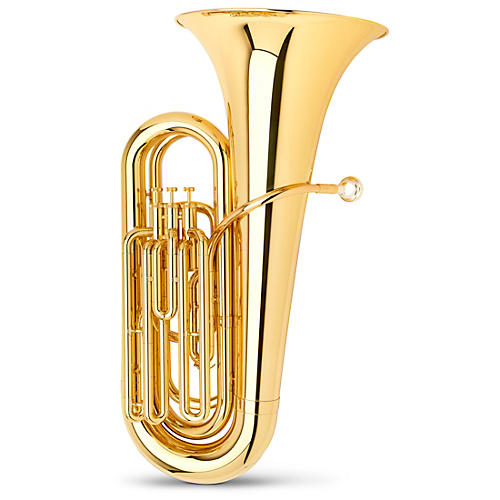
String Instruments
 String instruments are instruments that-- you guessed it -- use strings to create sound. By plucking, strumming, or using a bow, the strings vibrate, creating music. The finger position on the strings is what changes the pitch of the note. Playing an "open string"(no fingers placed on it) will give you the lowest note that string can play. By moving your finger up the instrument, you will get a higher and higher pitch.
String instruments are instruments that-- you guessed it -- use strings to create sound. By plucking, strumming, or using a bow, the strings vibrate, creating music. The finger position on the strings is what changes the pitch of the note. Playing an "open string"(no fingers placed on it) will give you the lowest note that string can play. By moving your finger up the instrument, you will get a higher and higher pitch.

Woodwind Instruments
 Woodwind instruments are instruments that are typically made from wood that require air to be blown into them to make sound. These instruments often times require reeds, little pieces of wood that allow the vibrations to occur. However, not all woodwind instruments do. Woodwinds change pitch by pressing different keys on the instrument, which closes or opens holes on it, causing a different pitch to transmit.
Woodwind instruments are instruments that are typically made from wood that require air to be blown into them to make sound. These instruments often times require reeds, little pieces of wood that allow the vibrations to occur. However, not all woodwind instruments do. Woodwinds change pitch by pressing different keys on the instrument, which closes or opens holes on it, causing a different pitch to transmit.

Percussion Instruments
 Percussion instruments are instruments that you hit (with mallet or hand), shake, or clap together to make noise. Percussion instruments are the beat makers of a song and keep time, such as the drum set or djembe. However, percussion instruments can also play music such as the timpani and piano, which is often times misclassified.
Percussion instruments are instruments that you hit (with mallet or hand), shake, or clap together to make noise. Percussion instruments are the beat makers of a song and keep time, such as the drum set or djembe. However, percussion instruments can also play music such as the timpani and piano, which is often times misclassified.

Brass Instruments
 Brass instruments are instruments that are played similar to woodwinds, but without reeds. They use a metal mouthpiece and require specific positioning of the players lips to produce sound. So, while it may look like the trumpet has very little keys and therefore can play a small amount of notes, it actually has a large range and just requires different buzzing and air from the mouth to make them. Unlike woodwinds, which play one note per finger positioning, brass can play many notes with the same positioning.
Brass instruments are instruments that are played similar to woodwinds, but without reeds. They use a metal mouthpiece and require specific positioning of the players lips to produce sound. So, while it may look like the trumpet has very little keys and therefore can play a small amount of notes, it actually has a large range and just requires different buzzing and air from the mouth to make them. Unlike woodwinds, which play one note per finger positioning, brass can play many notes with the same positioning.

Band
As with all bands, this type of band requires many people playing instruments together to perform music. However, for this specific type of band we will be focusing on the band found in most schools, marching bands. [7]
Bands include many people playing instruments in the percussion, brass, and woodwind category. Strings are often times omitted. They play at sports matches, pep rallies, and other school events. Many schools give scholarships for marching band, so it's also a great way to earn money for college.
Most of band involves performance: high steps, glide steps, backwards marching, etc. So, all you need to know about band is that if you like to play trumpet, clarinet, flute, or any of these band instruments, then band is probably the right choice for you.
Popular band songs include: "Oh When the Saints," "Eye of the Tiger," and many songs from the Rocky series.
Bands include many people playing instruments in the percussion, brass, and woodwind category. Strings are often times omitted. They play at sports matches, pep rallies, and other school events. Many schools give scholarships for marching band, so it's also a great way to earn money for college.
Most of band involves performance: high steps, glide steps, backwards marching, etc. So, all you need to know about band is that if you like to play trumpet, clarinet, flute, or any of these band instruments, then band is probably the right choice for you.

Popular band songs include: "Oh When the Saints," "Eye of the Tiger," and many songs from the Rocky series.

Orchestra
Orchestras in schools are very similar to orchestras in real life. All 4 instrument families are included, but only certain instruments from them. For example, you wouldn't find a guitar in an orchestra.

Unlike bands, orchestras play classical music by composers like Bach or Mozart. To rehearse in an orchestra, the members are divided into four sections based on instrument family, called sectionals. Then they are divided into subsections depending on skill. For example, a Violin 1 player would have harder sheet music than Violin 2 and so on.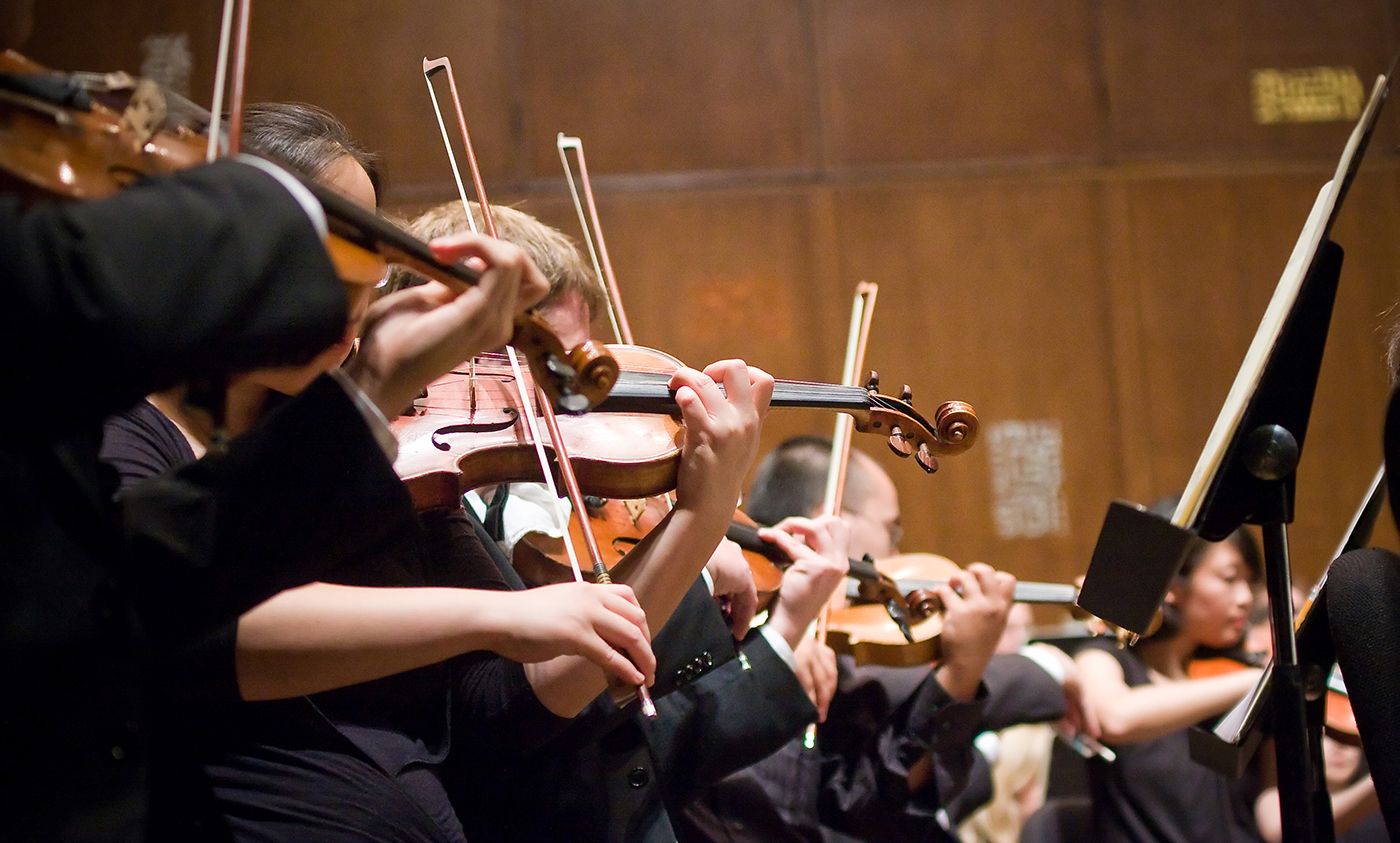
Orchestras perform at concerts, typically in winter and spring in a school year. If you are feeling confident in your ability, you can even enlist to join All-city or All-state orchestras wherever you are.

Unlike bands, orchestras play classical music by composers like Bach or Mozart. To rehearse in an orchestra, the members are divided into four sections based on instrument family, called sectionals. Then they are divided into subsections depending on skill. For example, a Violin 1 player would have harder sheet music than Violin 2 and so on.

Orchestras perform at concerts, typically in winter and spring in a school year. If you are feeling confident in your ability, you can even enlist to join All-city or All-state orchestras wherever you are.
Now that you understand the basics of music theory, it's time to put your knowledge to the test with this interactive quiz! Feel free to re-read the lesson for a refresher or move on to the test... if you're up for it!
:max_bytes(150000):strip_icc():format(webp)/jeop_logo_large-58bacf375f9b58af5cb69e2f.jpg)
:max_bytes(150000):strip_icc():format(webp)/jeop_logo_large-58bacf375f9b58af5cb69e2f.jpg)